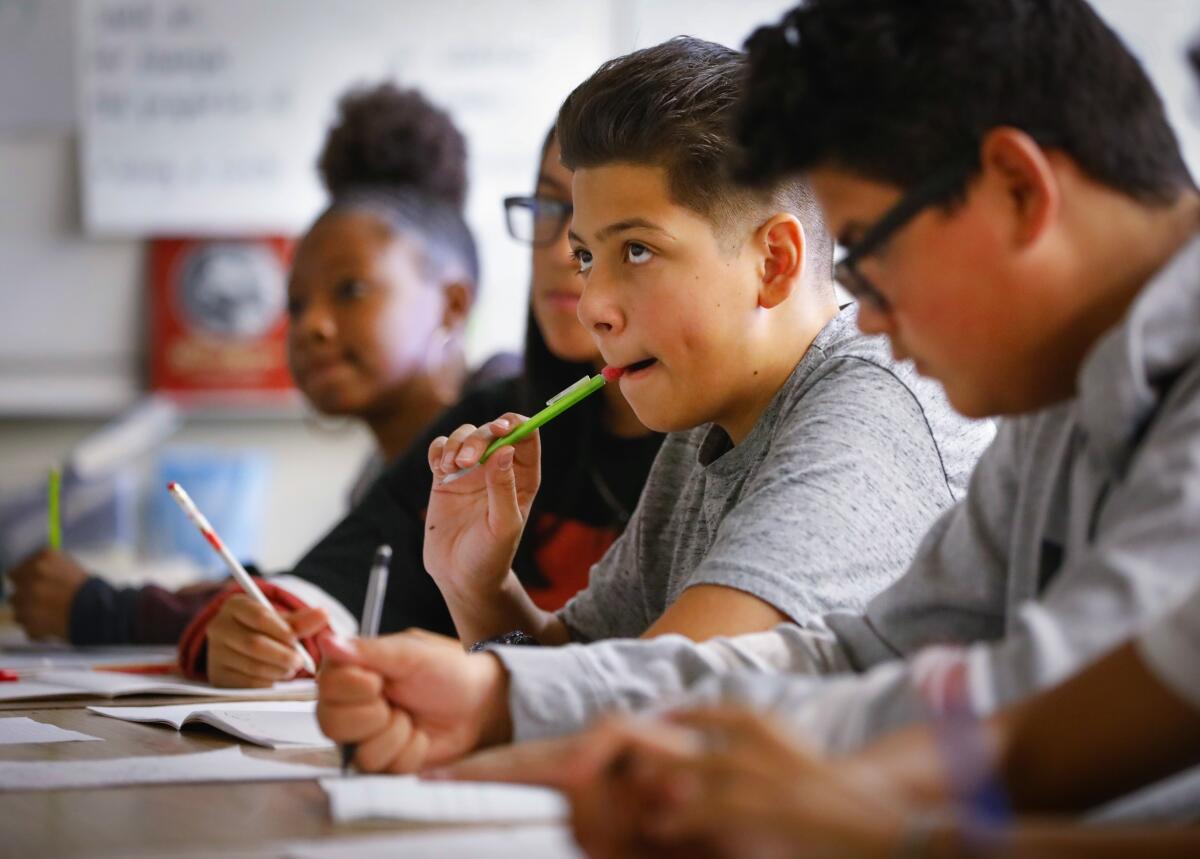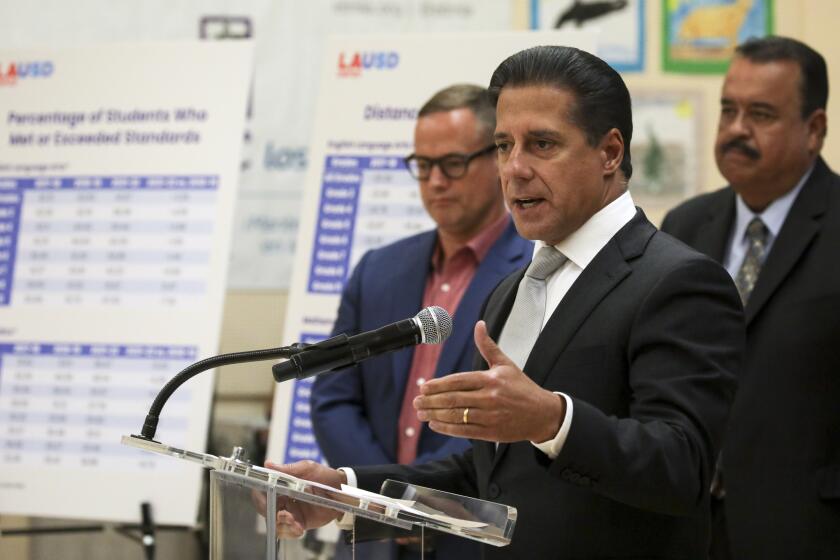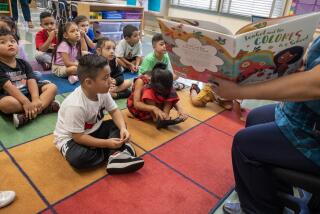Test scores across U.S. reveal ‘heartbreaking’ pandemic declines, with math hit hard

Eighth-graders in nearly every state across the nation and fourth-graders in a large majority of states, including California, saw significant drops in average math scores since the pandemic, reflecting “heartbreaking” academic setbacks for students across wide swaths of the country, according to the results of the “nation’s report card” released Sunday.
Average reading scores also declined in a majority of states, though California did not see a significant drop.
The falling scores spanned the political and demographic makeup of states, making it difficult to draw simple conclusions about the role the length of pandemic-related campus closures played in student performance, officials said. Overall, scores in Los Angeles, while alarmingly low, showed signs of resilience compared with other large urban districts, and sagging or stalled California scores fared slightly better than national averages.
The standardized test scores are especially concerning given that before the pandemic experts were already sounding the alarm about high rates of students across the nation not meeting basic proficiency in reading and math.
“The data prior to the pandemic did not reflect an education system that was on the right track,” said U.S. Education Secretary Miguel Cardona. “The pandemic simply made it worse. It took poor performance and dropped it down even further.”
That result, he said, is “heartbreaking and it’s horrible.”
A survey administered along with the tests found many teachers expressed insecurity about their ability to help students catch up — with about half saying they felt quite or extremely confident they would be able to help their students close pandemic-related gaps.
The rigorous standardized assessment known as the National Assessment of Educational Progress, which is administered by the National Center for Education Statistics, was given to a sample of fourth- and eighth-graders in early 2022.
The alarming dip in math proficiency and smaller declines in English in the last two pandemic-disrupted school years hit students who were already behind.
The test is administered to students in all 50 states, allowing for comparisons across the country to pre-pandemic 2019. It also includes results for many of the nation’s largest school districts, including Los Angeles Unified, which officials said was among the large districts whose scores, although low, reflected a “bright spot” of resilience.
Across the country, only about one in four eighth-graders met standards for proficiency on the national math assessment, down from about one in three in 2019.
In reading, about 31% of eighth-graders met standards for proficiency, down from about 34% in 2019.
The drop in math scores was especially steep and widespread, particularly for eighth-graders, a year that is a crucial stepping stone for higher level math. In California, where the vast majority of schools were closed until spring 2021, scores fell by 6 points. In Texas and Florida — where schools were able to reopen starting in fall 2020 — scores fell by 7 points, and in Oklahoma, where schools could also reopen in fall 2020, they fell by 13 points.
Peggy Carr, commissioner of the National Center for Education Statistics, said the National Assessment of Educational Progress results do not reveal clear-cut answers about how time spent in virtual classes affected students, given the student performance.
“There’s nothing in this data that says we can draw a straight line between the time spent in remote learning in and of itself, and student achievement,” she said.
A study earlier this year by researchers at Harvard University found that remote instruction was a primary driver of widening achievement gaps.
Carr said there is more research to be done to understand what role remote learning did play, including other factors that affected students and teachers during the pandemic, like mental health, access to internet and the quality of remote learning.
The quality of remote instruction was not uniform across the country. Some students spent the entire school day with a teacher for live virtual instruction, while others had minimal live lessons. Those who spent more live time online with a teacher showed better results.
In a survey administered along with the national assessment, about 39% of eighth-graders who performed in the lowest quartile on the reading test said they participated in real-time video lessons with their teacher every day or nearly every day.
Among those who performed in the highest quartile, about 74% said they had real-time lessons every day or nearly every day.
In California, the results were less dire than some experts had feared given that the school districts were among the last in the nation to bring students back to campus.
For California fourth-graders, math scores fell by 4 points. Texas and Florida saw 5-point drops, Colorado saw a 6-point drop and New York had a 10-point drop.
In reading, in fourth and eighth grades, California students showed no significant change in scores, even as a majority of states showed drops.
The results don’t mean California students are thriving. Before the pandemic, California was underperforming compared with national averages in reading and math.
The latest results mean that only about 30% of California eighth-graders are achieving proficiency in reading. About 23% are achieving proficiency in math.
Los Angeles Unified, meanwhile, was among the large districts with scores that Carr said demonstrated “pockets of resilience amidst all the chaos of the pandemic.”
L.A. fourth-graders saw a 4-point drop in math. That’s significant, but smaller than the vast majority of large urban districts that participated in the test. San Diego, for example, saw an 8-point drop. New York saw a 9-point drop and Baltimore City schools saw a 15-point drop.
The district was one of only four large school systems that saw no significant change in score for eighth-grade math.
In eighth-grade reading, meanwhile, L.A. Unified student scores increased by 9 points. It was the only large district to post a gain.
L.A. students, however, were also underperforming before the pandemic compared to with students in cities across the country.
With the 2022 score increase, about 28% of L.A. eighth-graders achieved proficiency in reading. About 17% achieved proficiency in math.
Supt. Alberto Carvalho said L.A. Unified took actions that benefited students, including swiftly pivoting to online learning. While he praised the gains, “there’s a lot of work to be done.”
“The reality is that overall performance is still very low,” he said.
National assessments show that 9-year-olds suffered big drops in reading and math scores, with students who were already struggling seeing the biggest decline.
California education officials are expected on Monday to release the results of the state’s Smarter Balanced assessments, which gauge how well students are doing meeting state standards in English language arts and math.
Last month, Los Angeles Unified released the results of its state assessment scores, which showed about 72% of students not meeting state standards in math and about 58% not meeting standards in English.
The dismal results in eighth-grade math on the national test were especially concerning because it comes at a pivotal moment for students, officials said. Declines were observed across most racial and ethnic groups and among higher and lower performing students.
“Eighth grade is that gateway, to more advanced mathematical course taking,” Carr said.
She said students probably struggled more with math because it was more difficult for families to support students with math at home. While many families encourage reading at home, it’s challenging for families to support math lessons.
The data should help inform how schools approach student recovery, officials said. School systems are required to spend 20% of American Rescue Plan school relief funds to address learning loss.
Roberto Rodríguez, assistant secretary for Planning, Evaluation, and Policy Development at the U.S. Department of Education, noted that about 56% of schools are using high-dosage tutoring to help students recover from academic setbacks and about 75% are offering summer learning and enrichment programs.
But it’s not enough, he said.
“We have to do more, and we have to spend more, and we have to approach that in a more urgent way,” he said.
More to Read
Sign up for Essential California
The most important California stories and recommendations in your inbox every morning.
You may occasionally receive promotional content from the Los Angeles Times.













